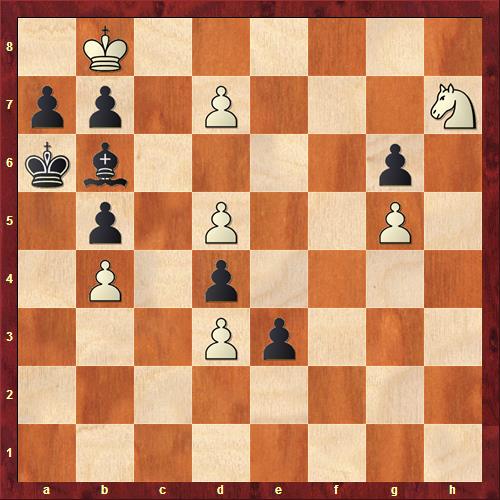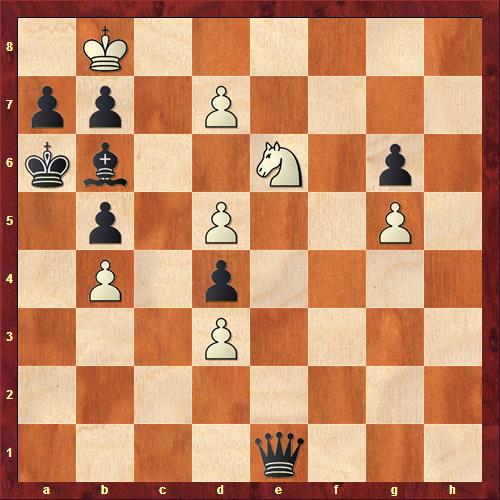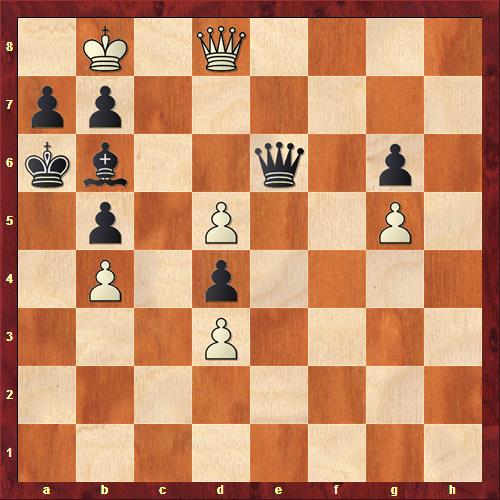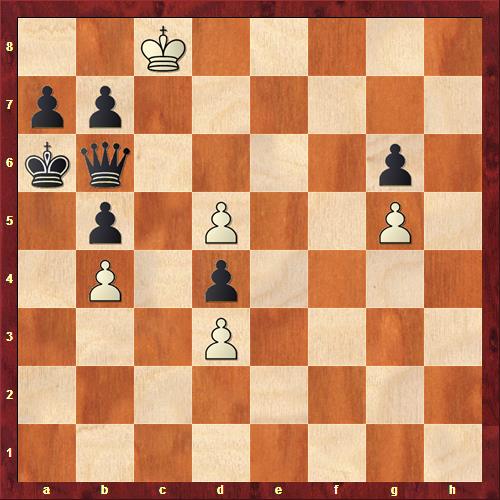This week I have another short, one-liner for you. It is another one I found at the end of one of Aviv Friedman's videos. He did not mention the composer, but I got a real kick out of it. The solution is short, but there is a lot of strategy packed into it. It is also one of those problems where you can be one move from the end and still not see where it is going.
White is to play and draw:

It sure does look bad for white, doesn't it? His passed pawn is firmly under control, while black's passed pawn is unstoppable. Game over, right?
Not so fast! There is one glimmer of hope: black's king is pretty boxed in. Can we take advantage of that?
Play begins 1. Nf8 e2 2. Ne6 e1Q.

White has brought his knight to within striking distance of the black king. But now what? Neither of the knight checks work, since black will just take the knight with his bishop and that will be that. For example, we might have: 3. Nc7+ Bxc7 4. Kxc7 Qg3+ 5. Kc8 Qxg5 6. d8Q Qxd8+ 7. Kxd8 and black wins easily by marching his g-pawn up the board.
But white has a trick: 3. d8Q!. Now black has a problem. If he takes the queen we have an immediate perpetual check with 3. ... Bxd8 4. Nc5+ Kb6 5. Nd7+ Ka6 6. Nc5+, and that's a draw.
So black tries 3. ... Qxe6!

Looks good! If white now takes black's queen, then black will take white's queen and just win prosaically with his big material advantage. But if white moves his queen to safety then black will do likewise, and again black will just win on material.
But white has another trick! He plays 4. Qxb6+! What can black do? Taking with the king or the pawn just loses, since white will take the black queen and then promote his pawn. So black must play 4. ... Qxb6. But isn't this good? White's down a whole queen!
But now we have the last trick. 5. Kc8!! and it's a draw.

Really! What can black do? His queen is his only mobile piece, but its only safe square is on d6. But 5. ... Qd6 is stalemate! So much for that.
On any other move white will just take the queen and a draw (or perhaps a black loss) will result. The only interesting line is 5. ... Qc6+ 6. dxc6 bxc6 7. Kc7 c5 8. bxc5 b4. But the race will end in a tie, and the wide open board will ensure that the white queen has no difficulty holding the draw.
Very nice! See you next week.

Quick question --
How would play continue if white promotes to knight instead of queen? Then ... Qxe6 is impossible, but I have crying twin babies at home and can't think through the rest at the moment.
The most direct move in such a case (after 3 d8(N)) is 3 ... Qxb4, where White is virtually in zugzwang. The threat is ... Qd6+ and ... Bxd8, winning the new knight, which has only one safe square. 4 Nb7 Qe7 threatens mate on b7. Then 5 Nec5+ Bxc5 6 Nxc5+ Qxc5 7 d6 Qc6 8 d7 Qb7# - and starting with 5 Nbc5+ is basically the same thing.
Err. First move knight can"t jump that far, surely?
Probably should have started on g7?
Obviously, White's 3rd is d8Q, not e8.
And kev's obviously thinking the 2nd move is the first. The Knight hops into the e6 square in 2 moves, not one.
Starting with White's move 3 it is just one shocker after another, and quite entertaining. (Well I suppose Black's only-move 4th won't qualify as shocker, but its predicament after White's 5th is comical.)
Nice one again, Jason!
Bill--
Thanks for pointing out the typo, which I've now corrected.
I spent much of the weekend watching the live broadcasts from the Millionaire Chess Open. Thrilling stuff!
That one looks like a White win to me: 9. c6 b3 10. c7 b2 11. c8(Q)+ followed by 12. Qc2 winning the Black passed pawn.
Black could also try 5. ... Qa5 6. bxa5 Kxa5 but this spots White two moves in the queening race. Black can still force White to exchange the queen for the passed pawn, but that exchange would be on the second rank, and White would win the queening race between his d pawn and Black's a pawn. So no better than a draw for Black, and easily a loss if Black misplays it.
jrosenhouse wrote (October 11, 2015):
> another short, one-liner for you. It is another one I found at the end of one of Aviv Friedman’s videos.[...] White is to play and draw:
> There is one glimmer of hope: [...] Play begins 1. Nf8 e2 2. [...]
Then how about 1. … Bd8 instead ?
Frank@7:
After 1 ... Bd8 White is better, as Black is not so close to queening; I believe Black actually loses rather than merely draws.
2 Ne6 e2 3 Nxd8 e1(Q) 4 Nxb7 Qe7 (if ... Qe5+ 5 d6!) 5 Kc8 and White will shortly just be a piece up.
GAZZA wrote (October 19, 2015):
> [1. Nf8 Bd8 ] 2 Ne6 e2 3 Nxd8 e1(Q) 4 Nxb7 Qe7 (if … Qe5+ 5 d6!)
Ah, 5. d6! (I had not seen that coming …)
Then might 5. … Qe5d5 (threatening mate by 6. … Qb7, or with prospective 6. … Qd6+) give black the advantage?
Off-topic, but may interest you:
Puzzling reaction: Sudoku brainteasers trigger man's seizures
Frank@9:
Unfortunately no. After 5 ... Qd5 6 Nc5+ wins outright. 6 ... Qxc5 is forced, after which 6 bxc5 b4 7 d8(Q) and it's all over for Black.
GAZZA wrote (October 20, 2015, #11):
> After 5 … Qd5 6 Nc5+ wins outright. [...]
Oh, right, it does (glimmer penetrantly, doesn't it?).
One final idea, then:
1. Nf8 e2 2. Ne6 e1Q. 3. d8Q! Qb4?
Frank@12:
Simple 4 Qd7 holds the draw then. White may even have the advantage, thanks to Black's pieces all being tangled up. After 4 Qd7, take a look at the board. Black's bishop can't move; if it goes to c7 it is taken with check; on 4 ... Bd8?? 5 Qxb7+ Ka5 6 Qxa7#; 4 ... Ba5?? 5 Qxb7#; 4 ... Bc5 5 Nxc5+ Qxc5 6 d6 and Black will struggle for the draw.
On most queen moves, 5 Nc7+ forces the exchange of bishop for knight after which again the d5 pawn is ready to run. Same thing with 4 ... Ka5 5 d6. A sample line might be:
4 ... Qc3 (to make a passed pawn for Black) 5 d6 Qxd3 6 Nc7+ Ka5 7 Qc8 and it is clear that White will win the race easily.
This is not to say that 3 ... Qxb4 loses for Black, but it definitely gives Black no winning chances.